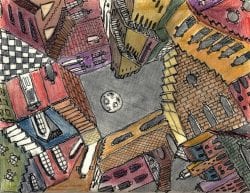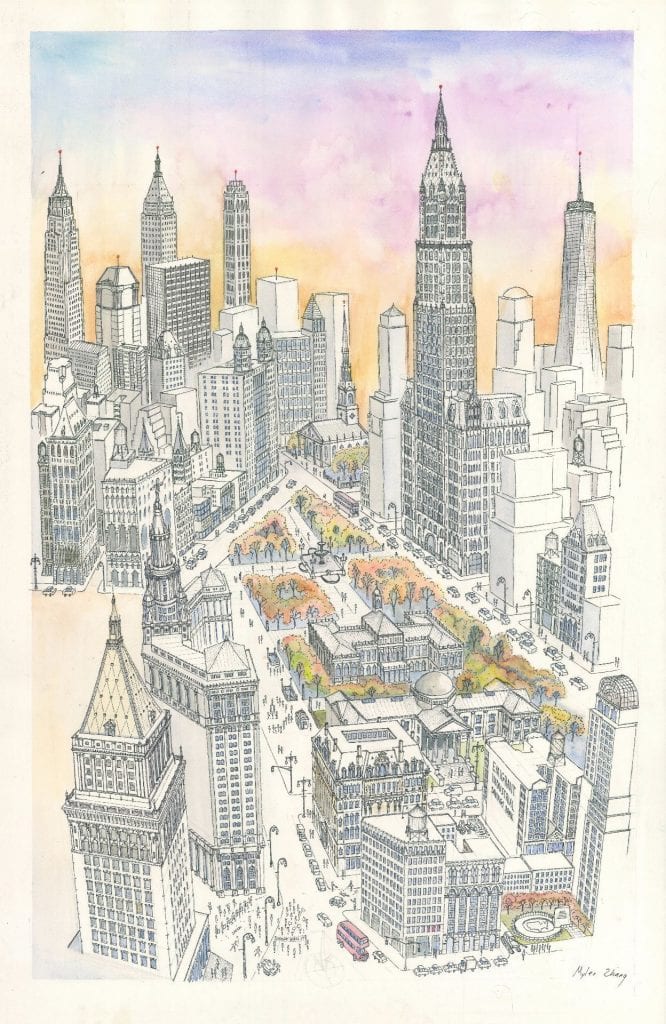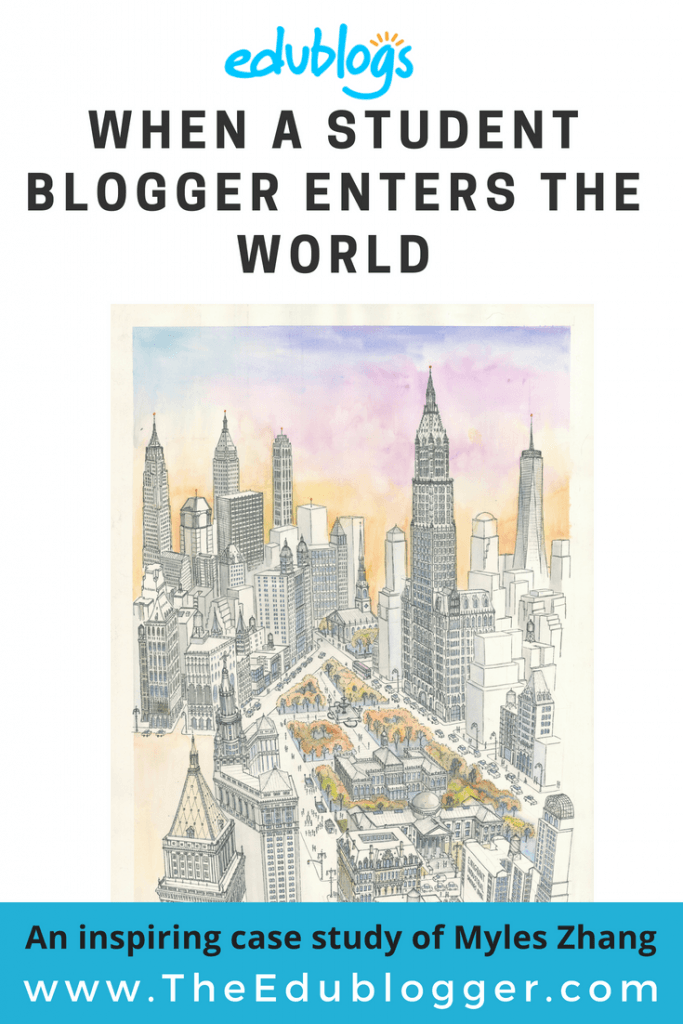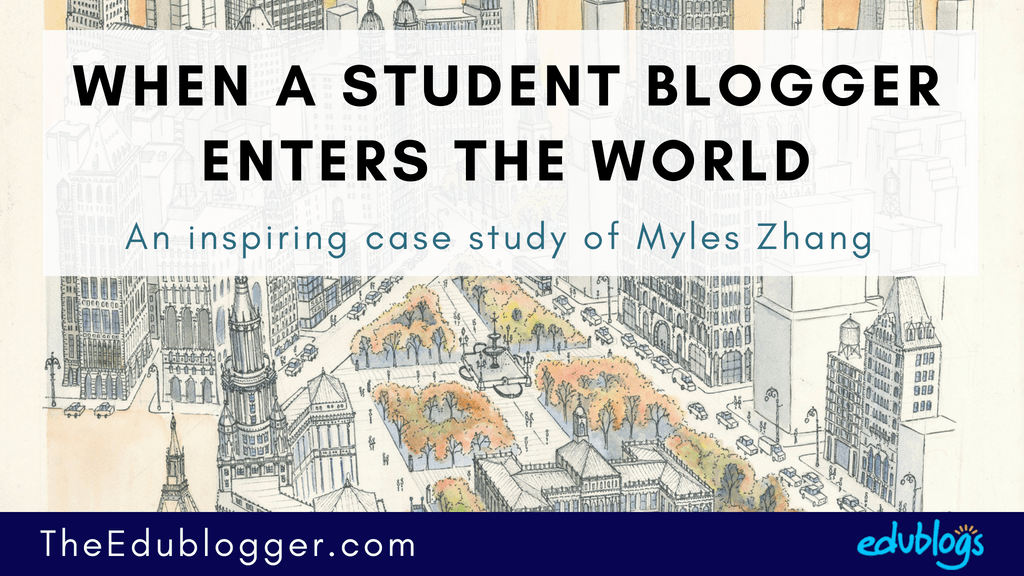 This is a guest post from Myles Zhang.
This is a guest post from Myles Zhang.
Myles is from New York City and is an undergraduate student at Columbia and at Oxford University. His academic studies and independent research focus on architectural and urban history, with a particular interest in the causes of urban decay.
Myles was introduced to blogging as a high school student and since then his online portfolio has grown and flourished.
The Seed Is Planted…
My experience with Edublogs began back in 2013 when my high school English teacher decided to teach “digital literacy”. She asked each of the 18 students in our class to set up a free blog on Edublogs.
My teacher never explicitly told us “how to blog”. But she gave us weekly writing assignments to respond to and post online.
I attended a school that was only just picking up on new ways to integrate technology in the classroom, like loaning each student a personal laptop. So, the whole experience felt a bit new and unfamiliar to me. From the start, I was excited by the idea of sharing my work online to reach a larger audience than my small, high school community of 75 students.
My teacher planted a seed. I ended up learning how to do things on my own.
Finding A Purpose
Within two weeks of joining Edublogs, I realized a personal website and digital portfolio could become a handy way to showcase my artwork and personal projects.
Over the previous five years, I had created a lot of artwork, merely to shelve it away in my dusty closet.

Over the following years, the website organically outgrew its initial use for high school and became an art portfolio, a place to publish my academic research in college, and a platform to spread awareness of issues like gentrification and traffic affecting my community.
I don’t know what to describe the site as now. I suppose it’s a “digital portfolio”. However, it’s more than just that … For me, it’s a creative opportunity to ask myself: “What work am I proudest of? And how can I best showcase this work online?”
Building and curating a website helps me answer these questions, and gain self-knowledge too.

The Power Of An Authentic Audience
This website also helps me reflect on my audience of readers. My high school teachers and now college professors often speak of the need to “consider one’s audience” when writing. For many of my research papers and essays in class, this audience is, unfortunately, no larger than the professor who reads my writing. But, for my website, the audience can be far larger — basically anyone with internet connection.
This authentic audience encourages me to be more mindful of what I share online. Maybe Edublogs helped me become a more conscientious writer. The experience also motivates me to create more because I know thousands of people might potentially see the results.

Show, Don’t Tell
In other ways, the website has been helpful in internships and college applications. In the automatic footer of all messages I send from my school email, I include a line that reads “More about Myles” with the link to my Edublogs site. Most people discover my site this way, like employers and people who commission watercolors from me.

A resume is often a list of things one claims to have done, which are not always substantiated. For me, it’s helpful to list something on my resume and then to provide the link to see the actual project at Edublogs.
My high school writing teachers always told me the mantra “show, don’t tell”. Resumes are all about telling in brief, bullet points (that are frankly, kind of boring to read). Websites are all about showing, through colorful essays, through drawings, and through embedded video content.
Edublogs has helped me put the mantra “show, don’t tell” into daily practice.
For instance, my project to depict New York City’s diverse and unique neighborhoods in watercolor and photo collages was the main part of my college application.
Or my summer project to document urban change through photography led to several dozen of my photographs being featured at an exhibit at my city’s public library.
A Personal Identity
In other contexts, friends and teachers learn another side of my personality that they never knew of before. In class and at school, I’d describe myself as being a bit introverted — so many of my friends don’t know that I can paint or draw until they see my website. In fact (and this might sound strange), I use my Edublogs website in lieu of posting on social media. In many ways, Edublogs feels like a more authentic and personalized platform to share my artwork than Facebook or Instagram.
Currently, I’d describe the website as a core part of my studies. It’s a way to increase my audience, improve my writing, curate my artwork, and teach myself web skills.
Many of the assigned essays I begin in class end up as larger and longer term projects and featured videos on my website.
More recently, I’ve become interested in building interactive models of gothic churches, computer simulations of gentrification, and animations of urban history – many of which I build from my small laptop in my dorm and feature on Edublogs for academic credit. These are all extensions of a small reading assignment or essay for class that inspired me to go further.
Amiens Cathedral: The Animated Experience from Myles Zhang on Vimeo.
Anyone Can Do It

I’ve never taken a class on website design. I can’t write computer code either. I don’t have one of those fancy computers with a powerful memory. I just have my five-year-old 13-inch laptop and an internet connection. But, there’s something powerful about web platforms like Edublogs and WordPress that give people the tools to build something that was simply impossible a mere twenty years ago.
There’s something equally powerful (and I feel democratic) about a simple web-link that opens up a world of information to anyone in the world. I feel that the world is becoming increasingly digital. Building and managing my website (several, in fact) has hopefully helped prepare me to more actively contribute to this digital world.
I’m just thankful to be a part of this creative process. And maybe through my website, I might inspire others to do the same.
I’m glad I stayed and grew with Edublogs all these years.
What a powerful story from the very talented Myles. Be sure to explore his site further as it is a real visual delight and such an excellent example of a finely curated portfolio.
We just love hearing about what students can do when a seed is planted in school. Blogging is such an authentic medium that can enhance one’s personal or professional life in so many ways.
Myles is following his passions, realizing the power of an authentic audience, building his own community, standing up for what he believes in, inspiring others, and unleashing all sorts of opportunities in his local community and beyond. What more could we want for our graduating students?
Exposing your students to blogging can truly be a gift that leads to endless possibilities.
We thank Myles for sharing his story and invite you to share your reactions or questions in the comment section below!
Recommended Reading
You might also be interested in reading the following posts about student blogging:
- My Class: Student Blogging Made Easy
- Blogging With High School Students: Roslyn Green’s Story
- 100+ Ideas And Prompts For Student Blogging
- Different Approaches To Using Student Blogs And Digital Portfolios


Wow! The artwork is amazing! I really enjoyed hearing Myles Zhang story of how he grew as a writer and as an artist. He is truly talented and that is awesome how blogs can help people show others who they are and what they are passionate about.
Agree with you, Vanessa! Myles’ work is truly inspiring!
Yes, good luck Anna!
These art work are really cool. Great job.
Blogging is a powerful tool indeed.
Wow! As Myles said, “show, don’t tell” is a powerful mantra. I am dipping my toes in the water of blogging, and have learned a ton in just the last 8 minutes. Thank you!
This is fantastic to here, Anna! Good luck with your blogging journey. We just loved hear Myles’ story too! Such an inspiration.
I love the drawling !!
u
*drawing